As a professional copywriting journalist, I am here to provide you with all the information you need about male dogs going on heat. Contrary to popular belief, male dogs do not experience heat cycles like their female counterparts. Instead, they exhibit a different pattern of reproductive behavior influenced by environmental cues and hormonal changes.
In this article, I will delve into the intricacies of male dogs’ reproductive behavior, explore the concept of the “mating season,” and help you understand the differences between male and female dogs in terms of their heat cycles. By gaining a comprehensive understanding of male dogs’ reproductive behavior, you will be better equipped to provide appropriate care for your furry companion.
Key Takeaways:
- Male dogs do not go through heat cycles like female dogs.
- Their reproductive behaviors are influenced by environmental cues and hormonal changes.
- Understanding the differences between male and female dogs’ reproductive behaviors is crucial for proper care.
- Neutering can have an impact on male dogs’ reproductive behavior, but individual responses may vary.
- Managing male dogs’ reproductive cycles requires providing appropriate stimulation and seeking guidance from a veterinarian when needed.
Understanding Heat Cycles in Female Dogs
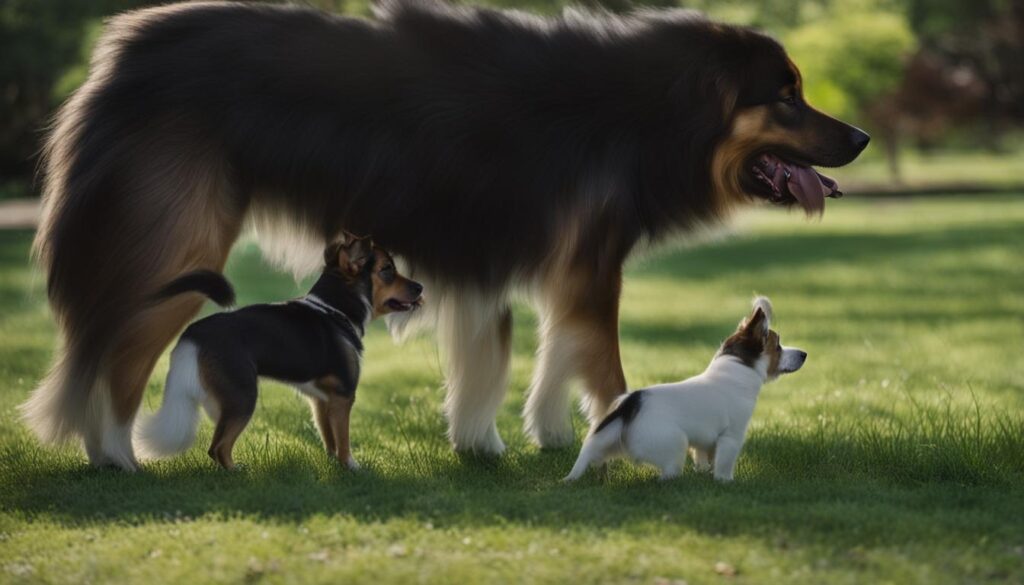
Female dogs go through heat cycles, also known as estrus, which is a recurring reproductive phase. Unlike male dogs, females have distinct stages in their heat cycle that prepare their bodies for mating and potential pregnancy. Let’s take a closer look at the different stages:
- Proestrus: This is the initial stage of the heat cycle and is characterized by hormonal changes in the female dog’s body. Estrogen levels increase, and the dog may exhibit signs such as vaginal bleeding and swollen vulva. During this phase, the female dog attracts male dogs but is not receptive to mating.
- Estrus: This is the most crucial stage of the heat cycle, often referred to as the “mating phase.” Estrogen levels peak, and the female dog becomes receptive to mating. She may display behavior such as flirting with male dogs, flagging her tail to the side, and urinating more frequently to leave scent markers.
- Diestrus: Following the estrus stage, diestrus begins. If the female dog hasn’t mated, her body prepares for the possibility of pregnancy. The reproductive system undergoes changes, and the female dog may lose interest in mating. This phase lasts for several weeks.
- Anestrus: Anestrus is the resting period between heat cycles. The female dog’s reproductive system returns to a dormant state, and there are no visible signs of being in heat. This phase typically lasts for several months.
Remember, these heat cycles are essential for female dogs’ reproductive abilities but do not apply to male dogs. Female dogs’ bodies undergo significant hormonal fluctuations and physical changes during their heat cycles, whereas male dogs do not have cyclical reproductive behavior like females.
Signs of a Female Dog in Heat
When a female dog is in heat, there are several signs to look out for:
- Swollen vulva
- Increased urinary frequency and marking behavior
- Bloody discharge during the proestrus stage
- Flirting behavior and flirting tail position
- Attracting male dogs and mounting them
| Heat Cycle Stage | Duration | Primary Characteristics |
|---|---|---|
| Proestrus | 7-10 days | Bloody discharge, swollen vulva |
| Estrus | 5-10 days | Peak receptivity to mating, flirting behavior |
| Diestrus | 60-90 days (if unmated) | Body prepares for pregnancy or returns to normal |
| Anestrus | Several months | Rest phase between heat cycles |
Male Dogs’ Reproductive Behavior: Exploring the Mating Season
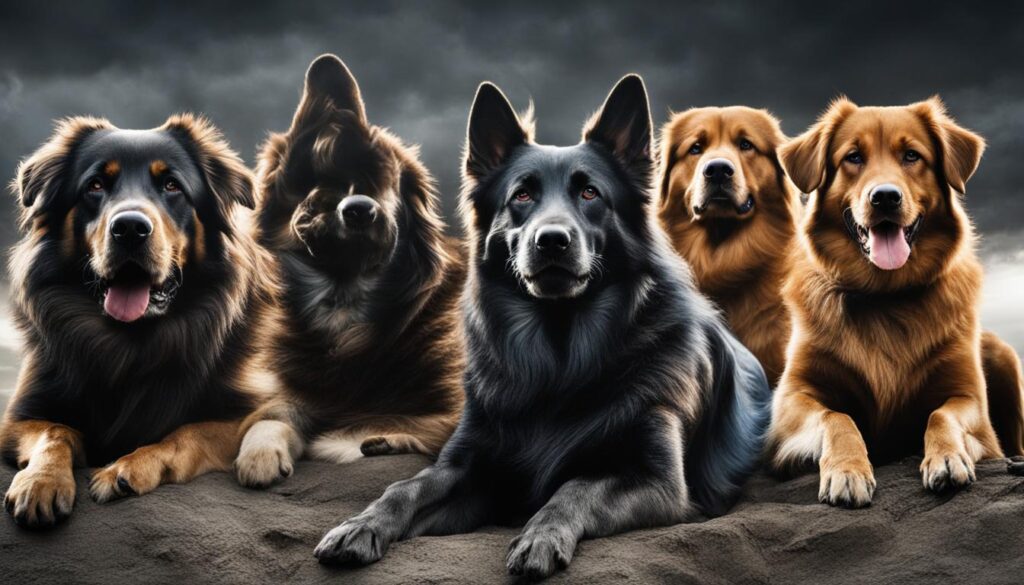
Male dogs display a unique reproductive behavior known as the “mating season.” Unlike female dogs with their well-defined heat cycles, male dogs don’t have a clear reproductive cycle. Instead, their behavior changes seasonally, influenced by hormonal fluctuations and environmental cues. During the mating season, male dogs exhibit increased activity in seeking potential mates and engaging in breeding behaviors.
This change in behavior is primarily driven by an increase in testosterone levels. As the days grow longer and the environment shifts, male dogs become more interested in marking their territory and attracting females. They may display behaviors such as increased vocalization, restlessness, and a heightened interest in females in estrus.
It’s important to note that the mating season varies based on factors such as breed, age, and individual characteristics. Some male dogs may exhibit a more pronounced mating season, while others may show milder changes in behavior.
To further understand male dog breeding behavior, let’s take a look at a table comparing the key characteristics of male and female reproductive cycles:
| Aspect | Male Dogs | Female Dogs |
|---|---|---|
| Hormonal Influence | Testosterone-driven | Estrogen and progesterone-driven |
| Reproductive Cycle | Seasonal-based behavior | Distinct heat cycles (proestrus, estrus, diestrus, and anestrus) |
| Physiological Changes | No physical signs of fertility | Visible signs of heat (vulvar swelling, bloody discharge) |
| Mating Behavior | Increased activity and interest during the mating season | Heightened receptiveness and attraction during estrus |
Understanding the differences between male and female reproductive behaviors is essential for pet owners to provide appropriate care and manage their male dogs’ behavior during the mating season. By recognizing these natural behaviors and seeking guidance from a veterinarian, pet owners can ensure the well-being of their male dogs.
Hormonal Fluctuations in Male Dogs
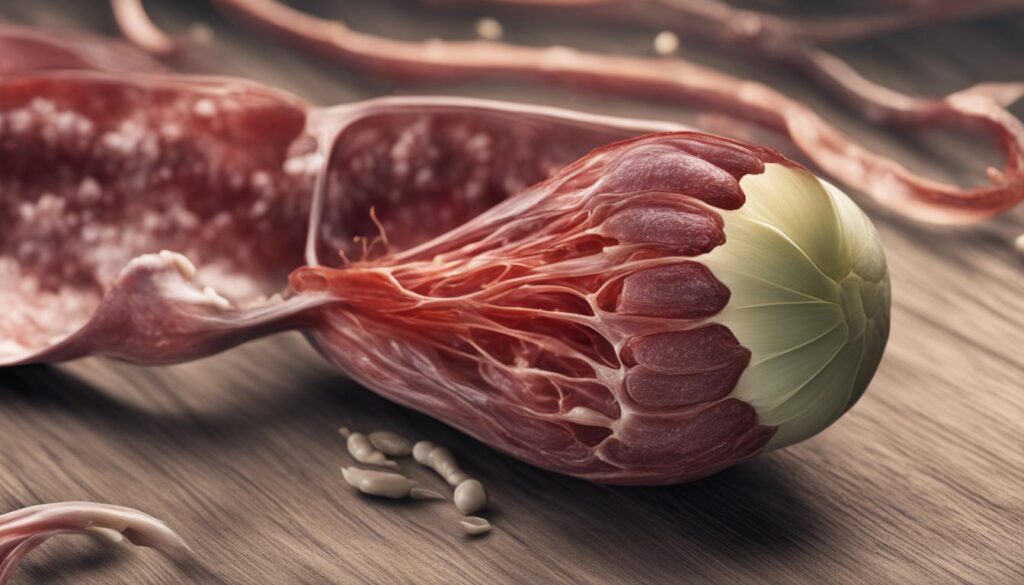
Hormones, particularly testosterone, play a crucial role in regulating the reproductive behavior of male dogs. Testosterone, a hormone produced by the testes, influences various behaviors associated with the mating season, enabling male dogs to respond to potential mates and competitors.
During the mating season, male dogs experience hormonal fluctuations that trigger changes in their behavior. Increased testosterone levels make them more receptive to the pheromones released by females in estrus, signaling their readiness to mate. This hormonal influence heightens their desire to seek out potential mates and engage in reproductive behaviors.
One common behavior exhibited by male dogs during the mating season is territorial marking. By urinating on objects or territories, male dogs communicate their presence to potential mates and competitors, asserting their reproductive fitness. This behavior serves to establish dominance and attract females.
| Behavior | Description |
|---|---|
| Increased receptiveness to pheromones | Male dogs become more responsive to the pheromones released by females in estrus, indicating their availability for mating. |
| Territorial marking | Male dogs mark their territory by urinating on objects or territories as a means to communicate their presence and attract potential mates. |
These hormonal fluctuations and associated behaviors are essential for male dogs to engage in successful reproduction. Understanding the role of hormones, like testosterone, in regulating male dogs’ reproductive behaviors can provide valuable insights into their natural instincts and facilitate proper care and management.
Dispelling the Myth: Male Dogs vs. Female Dogs in Heat

There is a common misconception that male dogs go through heat cycles like females. However, this is not accurate. Female dogs have distinct heat cycles marked by hormonal changes, while male dogs have a different pattern of reproductive behavior influenced by hormones and environmental triggers.
Male dogs may exhibit signs of increased reproductive activity, but these are not the same as the cyclical heat experienced by female dogs. Some male dog heat symptoms include:
- Restlessness
- Heightened vocalization
- Increased interest in females in estrus
These behaviors are a result of hormonal fluctuations, particularly changes in testosterone levels, which drive male dogs to respond to the presence of receptive females and engage in mating behaviors. It is important to note that these symptoms do not indicate a male dog going through a heat cycle like females.
As a pet owner, it is crucial to understand the differences in reproductive behavior between male and female dogs. This knowledge will help dispel the myth and ensure that you provide the appropriate care and attention to your male canine companion during the mating season.
| Female Dogs in Heat | Male Dogs in Mating Season |
|---|---|
| Distinct heat cycles | No heat cycles |
| Hormonal changes | Hormonal fluctuations |
| Receptive to mating | Seeking out potential mates |
| Physical signs of fertility | Restlessness, heightened vocalization, increased interest in females in estrus |
The Role of Neutering in Male Dogs’ Reproductive Behavior
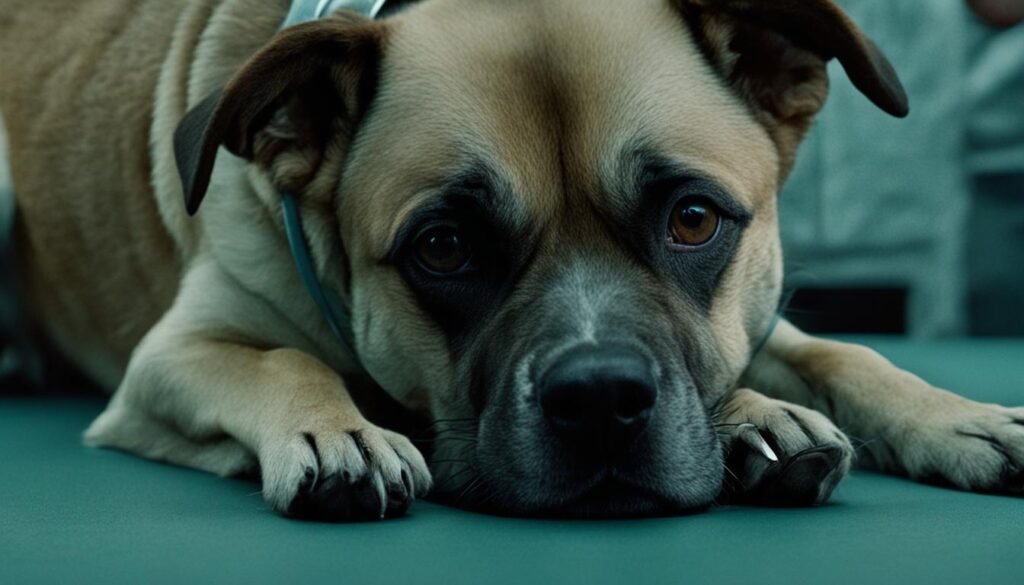
Neutering, or castration, plays a significant role in the reproductive behavior of male dogs. By removing the testicles, neutering reduces the influence of testosterone, the hormone responsible for driving mating-related behaviors. As a result, neutered male dogs are generally less likely to exhibit certain behaviors commonly associated with reproductive behavior, such as territorial marking, roaming in search of females, and aggression related to competition for mates.
Neutering is a commonly recommended procedure for pet owners who do not intend to breed their male dogs. It helps prevent unwanted behaviors and reduces the risk of certain health issues, such as testicular cancer and prostate problems. However, it’s important to note that individual responses to neutering may vary, and consulting with a veterinarian is crucial before deciding to proceed with the procedure.
Benefits of Neutering Male Dogs
Neutering male dogs offers several advantages, including:
- Reduced risk of certain health issues such as testicular cancer and prostate problems
- Diminished aggressive behavior related to competition for mates
- Elimination or reduction of territorial marking
- Decreased likelihood of roaming in search of females
- Prevention of unplanned litters
Considerations for Neutering Male Dogs
While neutering is generally recommended for pet dogs, certain factors should be taken into consideration:
- Age: The timing of neutering can impact the development of certain behaviors. It is recommended to consult with a veterinarian to determine the best age for neutering your male dog.
- Behavioral Issues: Neutering is not a guaranteed solution for all behavioral problems. Other training and behavior modification methods may need to be employed in conjunction with neutering.
- Health Status: If your male dog has pre-existing health conditions, it is important to discuss the potential risks and benefits of neutering with your veterinarian.
Managing Male Dogs’ Reproductive Cycles: Tips for Pet Owners
While male dogs do not experience traditional heat cycles, it’s important for pet owners to understand and manage their reproductive behavior. The mating season in male dogs can present its own set of challenges, and implementing the right strategies can help ensure their well-being. Here are some tips to manage male dog fertility:
- Provide indoor time: During the mating season, it’s advisable to provide male dogs with adequate indoor time. This helps minimize their exposure to potential mating triggers and reduces the likelihood of unwanted behaviors.
- Engage in mental and physical stimulation: Keeping male dogs mentally and physically stimulated can help redirect their focus and energy. Regular exercise, interactive toys, and training sessions can provide a healthy outlet for their natural instincts.
- Supervise outdoor activities: When male dogs are outdoors, it’s essential to closely supervise them to prevent unplanned mating encounters. Keeping them on a leash or within a securely fenced area can help ensure their safety and prevent unwanted pregnancies.
- Provide positive reinforcement: Rewarding desired behaviors with praise and treats can reinforce positive habits in male dogs. This can include exhibiting calm behavior around female dogs, responding to commands, and showing appropriate social interactions.
- Seek guidance from a veterinarian: If you have concerns about managing your male dog’s reproductive behavior, consulting with a veterinarian is recommended. They can provide expert advice, recommend appropriate strategies, and discuss the option of neutering if it aligns with your pet’s overall health and well-being.
By implementing these tips, pet owners can effectively manage male dogs’ reproductive cycles and ensure a safe and comfortable environment for their furry companions.
Comparing Male and Female Reproductive Behaviors in Canines
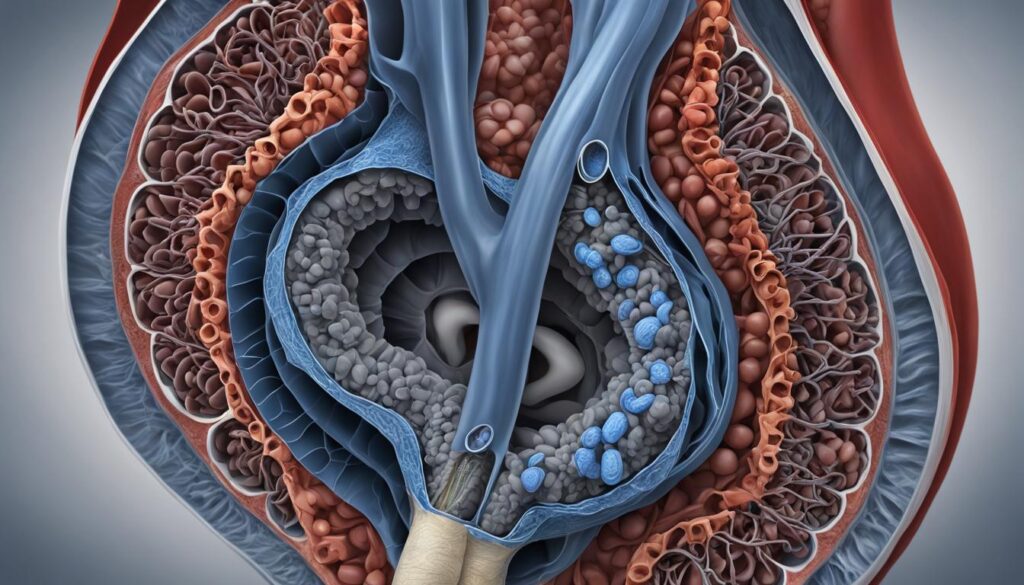
Male and female dogs have distinct reproductive behaviors that reflect their different biological roles. While female dogs go through cyclical heat cycles tied to their fertility, male dogs’ reproductive behaviors are influenced by environmental cues and hormonal changes.
Male dogs exhibit a mating season marked by changes in behavior and hormonal activity. This mating season is triggered by external factors such as increased daylight and the presence of receptive females. During this time, male dogs show increased activity in seeking out potential mates, marking their territory, and exhibiting behaviors to attract females.
Female dogs, on the other hand, undergo well-defined heat cycles that consist of proestrus, estrus, diestrus, and anestrus stages. These stages are characterized by hormonal changes and physical signs of fertility, such as swelling of the vulva and the release of pheromones.
These differences in reproductive behaviors can be attributed to the contrasting biological roles of male and female dogs. Male dogs have a biological instinct to pass on their genetic material, driving their behaviors during the mating season. Female dogs, on the other hand, go through heat cycles to prepare their bodies for potential reproduction.
By understanding and recognizing these differences, pet owners can provide appropriate care for their male and female dogs. It is important to be mindful of the unique challenges that come with managing male dogs’ reproductive cycles, such as ensuring their indoor time, providing mental and physical stimulation, and supervising them when outdoors.
In conclusion, male and female dogs exhibit contrasting reproductive behaviors due to their differing biological roles. While male dogs undergo a mating season influenced by environmental cues and hormonal changes, female dogs experience heat cycles related to their fertility. By understanding and accommodating these differences, pet owners can ensure the well-being of their furry companions.
Why Do Male Dogs Exhibit Changes in Behavior?
Male dogs exhibit changes in behavior primarily due to hormonal fluctuations, particularly changes in testosterone levels. These changes are aimed at helping them respond to the presence of receptive females and engage in mating behaviors. The behavioral changes in male dogs during the mating season are driven by the instinctual need to pass on their genetic material. Understanding the underlying biological and evolutionary reasons can provide insight into their instincts and behaviors.
Wrapping Up
Male dogs have a unique reproductive system that differs from that of their female counterparts. While female dogs go through heat cycles marked by hormonal changes, male dogs do not experience cyclical reproductive phases. Instead, they exhibit a mating season characterized by changes in behavior and hormonal activity influenced by environmental cues.
During the mating season, male dogs show increased activity in seeking out potential mates. This behavior is mainly driven by hormonal changes, particularly an increase in testosterone levels. Factors such as increased daylight and the presence of receptive females trigger male dogs’ reproductive behaviors.
Neutering, or castration, can play a significant role in modifying male dogs’ reproductive behavior. By reducing the influence of testosterone, neutering can help mitigate certain behaviors associated with the mating season, such as territorial marking and roaming in search of mates. However, it’s essential to note that individual responses to neutering may vary, and consulting with a veterinarian is advised.
Understanding and managing male dogs’ reproductive cycles are crucial for pet owners. By providing proper care and supervision during the mating season, pet owners can ensure the overall well-being of their male dogs. Ultimately, recognizing the distinctions between male and female reproductive behaviors allows for better care and management of our furry companions.
FAQ
Do male dogs go on heat?
No, male dogs do not go through heat cycles like female dogs. Instead, they exhibit a seasonal change in reproductive behavior known as the “mating season.”
What are the signs of a male dog in heat?
Male dogs in the mating season may show signs such as increased activity, restlessness, heightened vocalization, and an increased interest in females in estrus.
What is the male dog heat cycle?
Male dogs do not have a clear reproductive cycle like female dogs. They exhibit reproductive behaviors influenced by hormonal changes and environmental cues, rather than a defined heat cycle.
What is male dog breeding behavior like?
Male dogs exhibit behaviors such as increased interest in marking their territory, seeking out potential mates, and engaging in mating-related behaviors during the mating season.
What is the male dog reproductive system?
The male dog reproductive system consists of the testicles, penis, prostate gland, and other accessory glands that produce and transport sperm.
What role do hormones play in male dog fertility?
Hormones, particularly testosterone, play a crucial role in regulating male dogs’ reproductive behavior and fertility. Testosterone influences behaviors associated with the mating season and the attraction to receptive females.
Do male dogs exhibit the same symptoms as female dogs in heat?
No, male dogs do not exhibit the same cyclical symptoms as female dogs in heat. Male dogs in the mating season may show signs of increased reproductive activity, such as restlessness and an increased interest in females, but these are not the same as the cyclical heat experienced by female dogs.
Should I spay or neuter my male dog?
Neutering, or castration, can have a significant impact on male dogs’ reproductive behavior. It reduces the influence of testosterone and may help manage behaviors such as territorial marking, roaming, and aggression related to competition for mates. Consult with a veterinarian to make the best decision for your dog.
How can I manage my male dog’s reproductive cycles?
To manage your male dog’s reproductive behavior, provide indoor time, engage in mental and physical stimulation, supervise outdoor activities, provide positive reinforcement, and seek guidance from a veterinarian if needed.
What are the differences between male and female reproductive behaviors in canines?
Male and female dogs have distinct reproductive behaviors. Female dogs have cyclical heat cycles, while male dogs exhibit a mating season influenced by hormonal changes and environmental cues.
Why do male dogs exhibit changes in behavior?
Male dogs exhibit changes in behavior due to hormonal fluctuations, primarily changes in testosterone levels. These changes are driven by the instinctual need to respond to the presence of receptive females and engage in mating behaviors.






